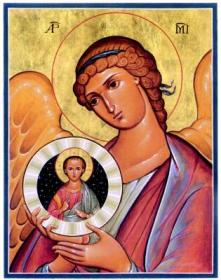When the faithful gather in the Angel Chapel each weekday at 6:45 AM to begin the daily cycle of prayers at St. Paul's, the first words we hear are these: "The Angel of the Lord announced unto Mary: And she conceived by the Holy Ghost." These are the opening versicle and response of the Angelus, a popular devotion commemorating the Incarnation. This devotion developed into its current form over a period of several centuries.
 In monasteries of the 10th century, the office of Compline was followed by three prayers, said kneeling by the monks. Each of the three prayers came to be accompanied by three tolls of a bell. By the 14th century, devout laymen would kneel in imitation of the monks and recite three Hail Marys when they heard the three triple tolls of the bell. The devotion was thought particularly appropriate to the hour of sunset, which was believed to be the time of day when the angel greeted Mary, "Hail, full of grace, the Lord is with thee: blessed art thou among women" (Luke 1:28). In time, the recitation of the three Hail Marys each evening became a familiar custom.
In monasteries of the 10th century, the office of Compline was followed by three prayers, said kneeling by the monks. Each of the three prayers came to be accompanied by three tolls of a bell. By the 14th century, devout laymen would kneel in imitation of the monks and recite three Hail Marys when they heard the three triple tolls of the bell. The devotion was thought particularly appropriate to the hour of sunset, which was believed to be the time of day when the angel greeted Mary, "Hail, full of grace, the Lord is with thee: blessed art thou among women" (Luke 1:28). In time, the recitation of the three Hail Marys each evening became a familiar custom.The monks also recited the three prayers, accompanied by the bell, in the morning after the office of Prime. Within another century, people were saying the three Hail Marys in the morning as well as the evening. The three triple tolls came to be known in some places as "the peace bell," and citizens were exhorted to pray the Hail Mary for the intention of the preservation of peace whenever they heard the bell.
 The third daily Angelus, at midday, was a later development. In some medieval cities, the bell was rung at noon on Fridays to commemorate the Passion of Christ. By the 16th century, the noon bell was rung daily, and the three familiar Hail Marys had come to precede the Passion prayer. It was also around this time that the modern Angelus versicles came to be associated with the devotion. The concluding prayer, however, apparently varied between the different times of day, commemorating the Resurrection in the morning, the Passion at midday, and the Incarnation in the evening. It was not until the 18th century that the Collect of the Annunciation became fixed as the regular concluding prayer.
The third daily Angelus, at midday, was a later development. In some medieval cities, the bell was rung at noon on Fridays to commemorate the Passion of Christ. By the 16th century, the noon bell was rung daily, and the three familiar Hail Marys had come to precede the Passion prayer. It was also around this time that the modern Angelus versicles came to be associated with the devotion. The concluding prayer, however, apparently varied between the different times of day, commemorating the Resurrection in the morning, the Passion at midday, and the Incarnation in the evening. It was not until the 18th century that the Collect of the Annunciation became fixed as the regular concluding prayer.Today, many churches still ring the Angelus bells two or three times each day, and good Catholics, upon hearing them, stop what they are doing for a few seconds, quietly joining in this brief devotion with Christians from across the centuries.


No comments:
Post a Comment